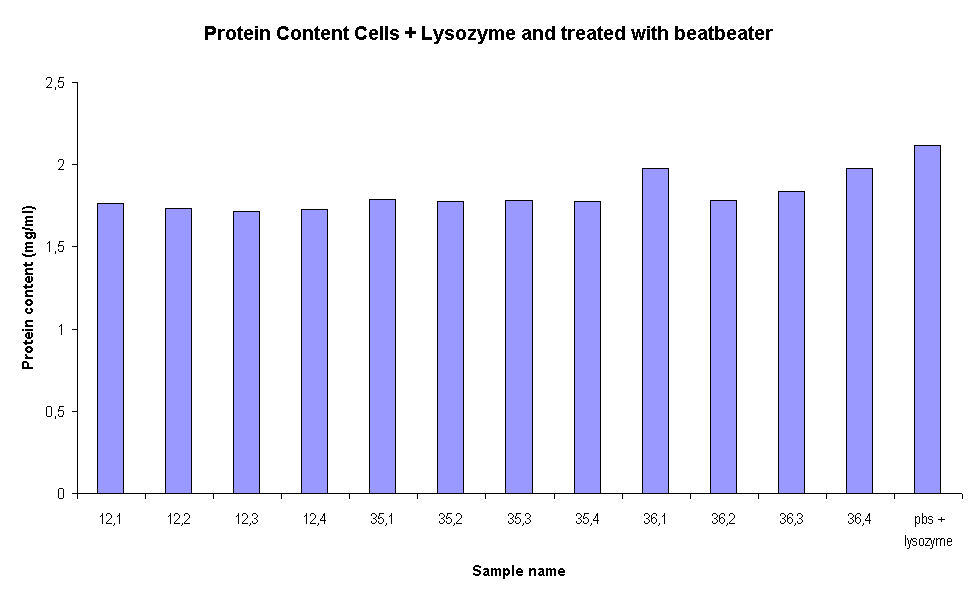TUDelft/21 October 2008
From 2008.igem.org
| July | ||||||
| M | T | W | T | F | S | S |
| 1 | 2 | 3 | 4 | 5 | 6 | |
| 7 | 8 | 9 | 10 | 11 | 12 | 13 |
| 14 | 15 | 16 | 17 | 18 | 19 | 20 |
| 21 | 22 | 23 | 24 | 25 | 26 | 27 |
| 28 | 29 | 30 | 31 | |||
| August | ||||||
| M | T | W | T | F | S | S |
| 1 | 2 | 3 | ||||
| 4 | 5 | 6 | 7 | 8 | 9 | 10 |
| 11 | 12 | 13 | 14 | 15 | 16 | 17 |
| 18 | 19 | 20 | 21 | 22 | 23 | 24 |
| 25 | 26 | 27 | 28 | 29 | 30 | 31 |
| September | ||||||
| M | T | W | T | F | S | S |
| 1 | 2 | 3 | 4 | 5 | 6 | 7 |
| 8 | 9 | 10 | 11 | 12 | 13 | 14 |
| 15 | 16 | 17 | 18 | 19 | 20 | 21 |
| 22 | 23 | 24 | 25 | 26 | 27 | 28 |
| 29 | 30 | |||||
| October | ||||||
| M | T | W | T | F | S | S |
| 1 | 2 | 3 | 4 | 5 | ||
| 6 | 7 | 8 | 9 | 10 | 11 | 12 |
| 13 | 14 | 15 | 16 | 17 | 18 | 19 |
| 20 | 21 | 22 | 23 | 24 | 25 | 26 |
| 27 | 28 | 29 | 30 | 31 | ||
Contents |
October 21st
New way for cell lysis: Bead Beater
A new protocol for cell lysis was tested: after 1ml of o/n LB culture (OD=~1) is resuspended in 1ml of PBS, 0.5g of small acid-washed glass beads and 20ul of 2uM lysozyme is added. The eppendorf tubes are shaked for 1h in the cold room on the Bead Beater. After this 600ul of the suspension is transferred to a fresh eppendorf tube. This is used to measure protein content and luciferase expression.
EDIT: Later this day, when protein content was measured, it was clear too much lysozyme was added. The concentration of the stock solution was too high. In figure 1 this can be seen. The maximum of the BCA measurement is 2 mg/ml, which we measure in every sample here. After we did some recalculation we estimated the concentration lysozyme was approximately 2 mg/ml. The experiment will be repeated.
 Figure 1: BCA of samples treated with lysozyme and beadbeater.
Figure 1: BCA of samples treated with lysozyme and beadbeater.
Concentrating DNA for sequencing
DNA in samples that had a total concentration of less than 100ng/ul was precipitated. This was done by adding 1/10 volume NaAc and 2.5 volumes 96% EtOH. This was stored at -20oC for several hours (at least 1h). Samples were centrifuged 20' @ max speed (14,000 rpm) and pellets washed with 1.5 volumes 70% EtOH. Again, samples were spun off (10' @ max) and resuspended in the desired volume of water (alternatively, TE buffer could also be used).
Growing Cells
Just like yesterday, K115012, K115035 and K115036 were grown o/n @ 30ºC. These tubes will be used to test the Bead Beater protocol properly.
 "
"